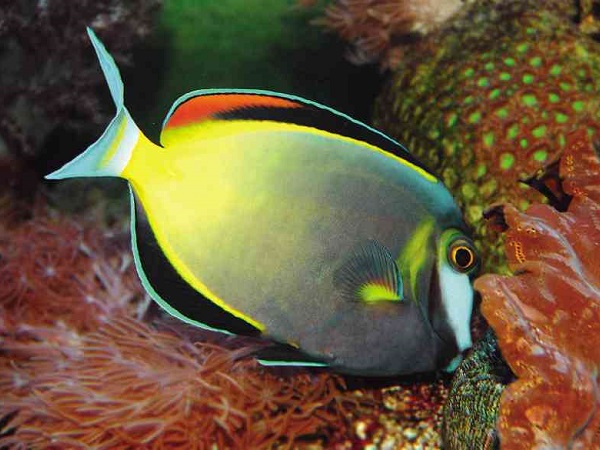
LIFESAVER The surgeonfish, a tropical bony fish known locally as “labahita,” may yet help heal the Tubbataha atolls from the damage inflicted by the groundings of a US Navy minesweeper in January and a Chinese fishing boat in April. GREGG YAN/WWF-PHILIPPINES
MANILA, Philippines—They aren’t the most beautiful fish in the sea, but the labahita may just be what the Tubbataha Reefs need to regenerate after being bruised by the intrusions of two foreign vessels earlier this year.
With the presence of labahita, also known as surgeonfish, two atolls in Tubbataha may heal in 30 to 40 years from the damage inflicted on them by the groundings of a US Navy minesweeper in January and a Chinese fishing boat in April, an expert said.
On the eve of Coral Triangle Day, the Worldwide Fund for Nature (WWF)-Philippines paid tribute to the reef-dwelling surgeonfish for its potential pivotal role in the regeneration of the World Heritage Site located in a remote spot in the Sulu Sea.
“Perpetually browsing on algae, forever ignored because of their dull colors, these little lawn mowers are the secret to Tubbataha’s recovery,” WWF-Philippines communications manager Gregg Yan said of the fish so named for the sharp, scalpel-like spikes on their tail.
Coral scientist Al Licuanan proposed the regeneration of the damaged atolls after a recent diving expedition to Tubbataha by a team of researchers and environmentalists, according to WWF-Philippines.
“The key to it all might be surgeonfish,” Licuanan said.
The constant grazing of the fish on algae keeps the seaweeds from taking over the freshly exposed rock, allowing coral larvae to resettle on the scars left by the groundings of the two vessels, he said.
“With enough luck, the scars should heal in 30 to 40 years,” Licuanan said.
Licuanan led the team of researchers, park rangers and environmentalists from the Tubbataha Management Office (TMO), the Department of Science and Technology, WWF-Philippines, the University of the Philippines Marine Science Institute, and De La Salle University to assess the damage caused by the groundings.
Chinese poachers
On April 8, a 48-meter-by-8-meter fishing vessel from China carrying 12 suspected poachers got stuck on an atoll in Tubbataha, destroying 3,902 square meters of coral, including a number of massive
500-year-old Porites corals sheared cleanly in half, WWF-Philippines said.
The vessel was confiscated and the poachers charged and fined.
The incident happened three months after the minesweeper USS Guardian ran aground on another atoll in Tubbataha on Jan. 17.
Salvors had to dismantle the vessel piece by piece to save the reef from further damage.
The last part of the warship, the stern, was removed from the reef on March 30.
By the time the ship was completely removed, some 2,345 sq m of coral had been destroyed, WWF-Philippines said.
The Tubbataha Reefs Natural Park is located in the center of the Sulu Sea. It protects nearly 100,000 hectares of high-quality marine habitats including three atolls and a large area of deep sea.
Tubbataha is home to whales, dolphins, sharks, turtles and Napoleon wrasse. It supports more than 350 species of coral and about 500 species of fish and for this, it has been declared a World Heritage Site by the United Nations Educational, Scientific and Cultural Organization (Unesco).
The marine park also protects one of the few remaining colonies of breeding seabirds in the region, according to
Unesco.
Tourists welcome
Tourists are welcome in Tubbataha, and a 12-hour, live-aboard cruise can be booked in Puerto Princesa City. But strong waves confine recreational diving to the months of April, May and June, WWF Tubbataha project manager Marivel Dygico said.
“Tubbataha earned its moniker from visiting Samal tribesmen who called it ‘long reef,’ after the exposed coral formations revealed daily by the tide,” she said.
The rich biodiversity in the Tubbataha waters translates into unrivaled productivity, according to WWF-Philippines.
“Whereas a typical square kilometer of healthy coral reef yields up to 40 metric tons of seafood yearly, Tubbataha generates over 200,” the group said.
Fishing within the marine park is not allowed, leaving the fish and other marine life in its waters to enrich the farther reaches of the Sulu Sea with spawn.
Coral Triangle
WWF-Philippines’ Yan described Tubbataha as the “undisputed jewel of the Coral Triangle,” a marine area encompassing portions of the tropical waters of the Philippines, Indonesia, Malaysia, Papua New Guinea, the Solomon Islands and Timor-Leste.
The Coral Triangle is home to 30 percent of the world’s coral reefs, 75 percent of coral species and almost 3,000 species of fish, according to TMO.
“Ocean currents carry larvae from the Coral Triangle to other parts of the world, supplying the globe with marine resources. It is the geographic center of global marine biodiversity and an international priority for conservation,” TMO said.
Coral Triangle Day, a global celebration of the epicenter of the world’s marine biodiversity, is marked on June 9 each year, in conjunction with World Oceans Day, observed the day before, TMO said.
Reef degradation
About 85 percent of the reefs in the Coral Triangle are in decline, with the Philippines leading in reef degradation, World Resources Institute said in a recent study called “Reefs at Risk.”
As of 2010, only 1 percent of Philippine reefs, including Tubbataha, are in excellent condition, and about 40 percent are in poor condition, the Department of Environment and Natural Resources said.